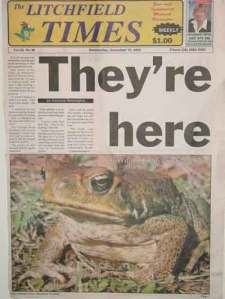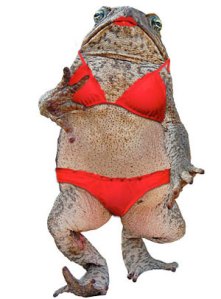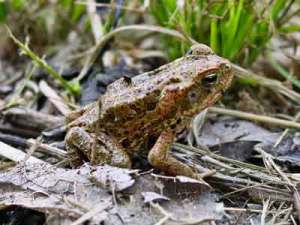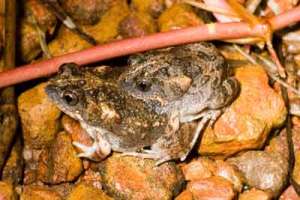I was on Facebook reading a friend’s status which went something like this: so-and-so “dreams of a better world…where chickens can cross the road without having their motives questioned.” Then someone commented underneath with: “where cane toads are free to roam without being mistaken for being a golf ball.”
Cane Toad killing is quite a controversial topic. Australians loath these amphibians and their destructive nature on our unique Australian biodiversity. Fueling that anger is the quick spread of this species. From being introduced in Far North Queensland, to then crossing over to the Northern Territory and now popping up all over Western Australia and trickling down into New South Wales.
The great cane toad debate usually rears its head when you spot one and autopilot switches on and you go to dispose of it in front of someone who was perhaps not born in Australia and is absolutely horrified by what you are about to do (although I also know some people who are Australian-born and don’t agree with killing them either). “How could you even think about killing an animal?” I don’t like killing animals at all, but for some strange reason, cane toads feel so very different. They feel like the enemy in a battle for my beloved Australia. A battle we seem to be losing!
Australia is a continent with no native toad species. Other countries have toads that are harmless and therefore people from overseas can not see why Australians get so fired up over a toad sighting…and don’t get me started on their reaction to Toad Day Out. It could be a cultural thing, or an animal rights thing, or an educational thing, or even a reason to just disagree with others thing. Feel free to comment with your opinion. I’m interested and I know some of my subscribers would be as well. It is always helpful to get an understanding of other people’s viewpoints on something so controversial.
I admit I have always been pro-cane toad eradication. I remember watching a film in high school during Science class about the massive outbreak of cane toads in Northern Queensland (I think this was before we dissected one….probably so we wouldn’t feel so bad?). I can vividly recall the footage of a man driving his jeep down a road COMPLETELY covered with cane toads….and he was doing his very best to swerve and skid across the entire road to squash as many as he could in his path. He was so angry about the outbreak. It was actually quite glorious once we understood the facts concerning cane toads and I could think of a few great backing tracks for that clip (Chariots of Fire anyone?).
Here are some fair-dinkum reasons why most Aussies hate canies –

In the early years (up to the 1960’s or so), the toad invasion front advanced fairly slowly – about 10 km each year. But then it began to speed up, and has kept accelerating. The front now moves at about 40 to 60 km per year, and our radio-tracking shows that this is because individual toads at the front travel long distances (sometimes more than a kilometre) each night – and do so every night. This is an incredible rate for an amphibian: cane toads at the Aussie invasion front travel much much faster and further than any other frogs or toads that have been studied elsewhere in the world.
1. 101 cane toads were deliberately introduced in 1935 from Hawaii to help get rid of the Cane Beetle, which was eating our QLD sugar cane. They had huge success in Hawaii with the cane toad as a form of cane beetle control, so thought they would try it over here. Unfortunately it didn’t work and the cane toad has become Australia’s most invasive species which occupies over 500,000km2 of Australia with 2,000 toads per hectare.
2. Cane Toads are extremely poisonous. Our natural fauna become very sick and die when they come in contact with the poison and pets can also die if they tamper with the toad. People have also died (not in Australia) when they have eaten the cane toad or made it into a stew. Some Australians have gotten very sick when they have gotten the poison into their system. When Cane Toads are threatened, they release a toxin (bufotoxin) from the glands behind the eyes and across their back. All stages of the Cane Toad’s life-cycle are poisonous, including the tadpole stage. This means that Cane Toads may negatively impact a wide diversity of wildlife. While it has been very difficult to quantify the losses to native animals as a result of Cane Toad invasion, evidence suggests that Northern Quolls, goannas, frogs, snakes, fish, Freshwater Crocodiles and egrets are particularly affected by the invasion. The Cane Toad has been nominated for listing as a key threatening process under the Environment Protection and Biodiversity Conservation Act 1999.
3. They eat our native frogs, tadpoles and frog eggs, wiping out some species. They also eat major amounts of honey bees (if you have seen the Bee Movie, you would know what can happen when we get rid of bees).
4. They multiply and spread like there is not tomorrow. Female cane toads can lay up to 35,000 eggs in one go, so the ones that are eliminated are replaced very quickly, plus a few more thousand. That is why a lot of people focus on getting rid of the eggs.
5. Because there are so many cane toads covering the northern half of Australia (at the moment), our native animals, reptiles and insects have to compete with them when finding food.
So, what can you do to help minimise the impact of Cane Toads in Australia?
- Stop the Cane Toad (& keep WA free from cane toads)
- Tips for around your home to keep cane toads away
- Other methods for killing a cane toad
Before you go out and buy your golf club or begin to cane proof your home, you must educate yourself on the difference between an actual cane toad and a native frog (some frogs look like cane toads and are endangered).
The easiest way to identify a cane toad is by its size. Cane toads are much larger than frogs and are one of the largest toads in the world. If the cane toad is large enough, you can see its poisonous shoulder glands and warty skin. It is a bit harder to tell the difference though if the frog or toad is small and young. Even scientists and biologists can sometimes have trouble telling the two apart. The best idea is to search pictures on the Internet.
My husbands opinion: ‘you can’t be passive about this. There is no opting out. If you decide not to kill cane toads, you have chosen instead to contribute to the destruction of Australia’s unique and native wildlife.’
Opinions?




Posted by Birdella on May 9, 2011 at 11:03 pm
Ok so these frogs are annoying i can solve your problem and why NO ONE else has though of this I dont know why… Take a animal either female OR male and bring them into eat the cane toads once they have eaten them all you wont be left with another species to irraticate because they will all be the same gender, wow i fixed 6 year problem in two seconds!!! OH and make sure if you bring an amphibians in that can change sexes to reproduce…. Good luck
Posted by Birdella on May 9, 2011 at 11:04 pm
i meant *cant change sexes*
Posted by Man» Blog Archive » Cane toads young pictures on June 21, 2011 at 4:27 am
[…] Unbeloved Cane Toad В« UNEARTHING THE SPUD Mar 30, 2011 … The best idea is to search pictures on the Internet. Young Cane Toad. Old Cane Toad … […]